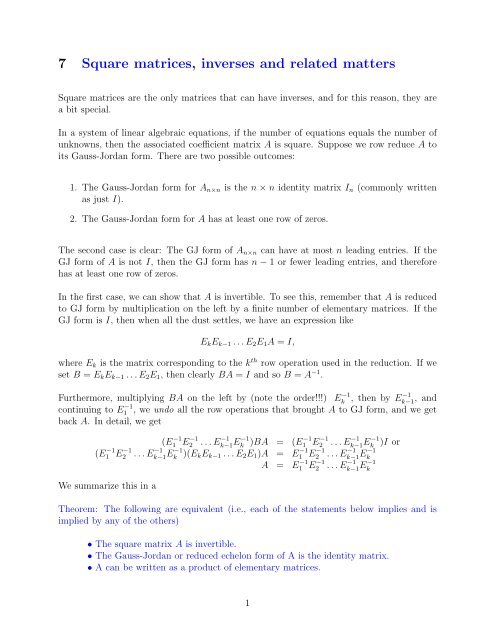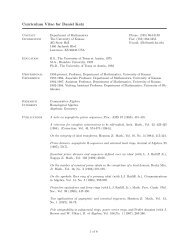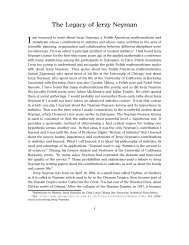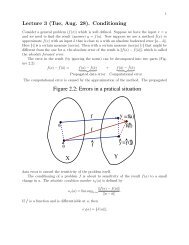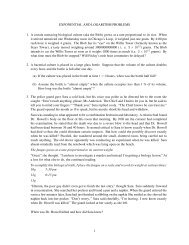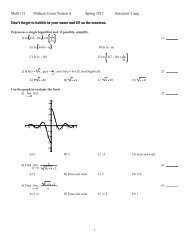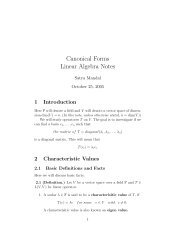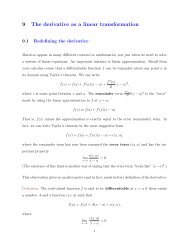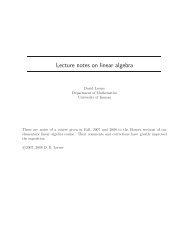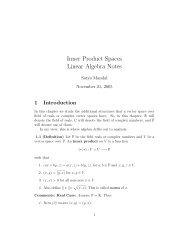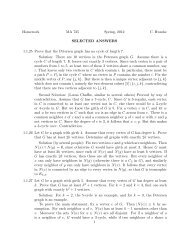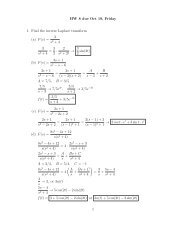Square matrices, inverses, etc.
Square matrices, inverses, etc.
Square matrices, inverses, etc.
Create successful ePaper yourself
Turn your PDF publications into a flip-book with our unique Google optimized e-Paper software.
7 <strong>Square</strong> <strong>matrices</strong>, <strong>inverses</strong> and related matters<br />
<strong>Square</strong> <strong>matrices</strong> are the only <strong>matrices</strong> that can have <strong>inverses</strong>, and for this reason, they are<br />
a bit special.<br />
In a system of linear algebraic equations, if the number of equations equals the number of<br />
unknowns, then the associated coefficient matrix A is square. Suppose we row reduce A to<br />
its Gauss-Jordan form. There are two possible outcomes:<br />
1. The Gauss-Jordan form for A n×n is the n × n identity matrix I n (commonly written<br />
as just I).<br />
2. The Gauss-Jordan form for A has at least one row of zeros.<br />
The second case is clear: The GJ form of A n×n can have at most n leading entries. If the<br />
GJ form of A is not I, then the GJ form has n − 1 or fewer leading entries, and therefore<br />
has at least one row of zeros.<br />
In the first case, we can show that A is invertible. To see this, remember that A is reduced<br />
to GJ form by multiplication on the left by a finite number of elementary <strong>matrices</strong>. If the<br />
GJ form is I, then when all the dust settles, we have an expression like<br />
E k E k−1 . . . E 2 E 1 A = I,<br />
where E k is the matrix corresponding to the k th row operation used in the reduction. If we<br />
set B = E k E k−1 . . . E 2 E 1 , then clearly BA = I and so B = A −1 .<br />
Furthermore, multiplying BA on the left by (note the order!!!) E −1<br />
k<br />
, then by E−1<br />
k−1 , and<br />
continuing to E1 −1 , we undo all the row operations that brought A to GJ form, and we get<br />
back A. In detail, we get<br />
(E −1<br />
1 E −1<br />
2 . . . E −1<br />
k−1 E−1 k<br />
)BA = (E−1 1 E2 −1 . . . E −1<br />
k−1 E−1 k<br />
(E1 −1 E2 −1 . . . E −1<br />
k−1 E−1 k )(E kE k−1 . . . E 2 E 1 )A = E1 −1 E2 −1 . . . E −1<br />
k−1 E−1 k<br />
We summarize this in a<br />
A = E1 −1 E2 −1 . . . E −1<br />
k−1 E−1 k<br />
)I or<br />
Theorem: The following are equivalent (i.e., each of the statements below implies and is<br />
implied by any of the others)<br />
• The square matrix A is invertible.<br />
• The Gauss-Jordan or reduced echelon form of A is the identity matrix.<br />
• A can be written as a product of elementary <strong>matrices</strong>.<br />
1
Example - (fill in the details on your scratch paper)<br />
We start with<br />
A =<br />
( 2 1<br />
1 2<br />
We multiply row 1 by 1/2 using the matrix E 1 :<br />
( 1<br />
0<br />
E 1 A =<br />
2<br />
0 1<br />
)<br />
A =<br />
)<br />
.<br />
( 1<br />
1<br />
2<br />
1 2<br />
)<br />
.<br />
We now add -(row 1) to row 2, using E 2 :<br />
( 1 0<br />
E 2 E 1 A =<br />
−1 1<br />
) ( 1<br />
1<br />
2<br />
1 2<br />
)<br />
=<br />
( 1<br />
1<br />
2<br />
0 3 2<br />
)<br />
.<br />
Now multiply the second row by 2 3 :<br />
( 1 0<br />
E 3 E 2 E 1 A =<br />
0 2 3<br />
) ( 1<br />
1<br />
2<br />
0 3 2<br />
)<br />
=<br />
( 1<br />
1<br />
2<br />
0 1<br />
)<br />
.<br />
And finally, add − 1 (row 2) to row 1:<br />
2<br />
( 1 −<br />
1<br />
E 4 E 3 E 2 E 1 A =<br />
2<br />
0 1<br />
) ( 1<br />
1<br />
2<br />
0 1<br />
)<br />
=<br />
( 1 0<br />
0 1<br />
)<br />
.<br />
So<br />
A −1 = E 4 E 3 E 2 E 1 = 1 3<br />
( 2 −1<br />
−1 2<br />
)<br />
.<br />
Exercises:<br />
• Check the last expression by multiplying the elementary <strong>matrices</strong> together.<br />
• Write A as the product of elementary <strong>matrices</strong>.<br />
• The individual factors in the product of A −1 are not unique. They depend on how we<br />
do the row reduction. Find another factorization of A −1 . (Hint: Start things out a<br />
different way, for example by adding -(row 2) to row 1.)<br />
• Let<br />
A =<br />
( 1 1<br />
2 3<br />
Express both A and A −1 as the products of elementary <strong>matrices</strong>.<br />
)<br />
.<br />
2
7.1 Solutions to Ax = y when A is square<br />
• If A is invertible, then the equation Ax = y has the unique solution A −1 y for any right<br />
hand side y. For,<br />
Ax = y ⇐⇒ A −1 Ax = A −1 y ⇐⇒ x = A −1 y.<br />
In this case, the solution to the homogeneous equation is also unique - it’s the trivial<br />
solution x = 0.<br />
• If A is not invertible, then there is at least one free variable (why?). So there are nontrivial<br />
solutions to Ax = 0. If y ≠ 0, then either Ax = y is inconsistent (the most<br />
likely case) or solutions to the system exist, but there are infinitely many.<br />
Exercise (*): If the square matrix A is not invertible, why is it “likely” that the inhomogeneous<br />
equation is inconsistent? “Likely”, in this case, means that the system should be<br />
inconsistent for a y chosen at random.<br />
7.2 An algorithm for constructing A −1<br />
The work we’ve just done leads immediately to an algorithm for constructing the inverse of<br />
A. (You’ve probably seen this before, but now you’ll know why it works!). It’s based on<br />
the following observation: suppose B n×p is another matrix with the same number of rows as<br />
A n×n , and E n×n is an elementary matrix which can multiply A on the left. Then E can also<br />
multiply B on the left, and if we form the partitioned matrix<br />
C = (A|B) n×(n+p) ,<br />
Then, in what should be an obvious notation, we have<br />
where EA is n × n and EB is n × p.<br />
EC = (EA|EB) n×n+p ,<br />
Exercise: Check this for yourself with a simple example. (*)Better yet, prove it in general.<br />
The algorithm consists of forming the partitioned matrix C = (A|I), and doing the row<br />
operations that reduce A to Gauss-Jordan form on the larger matrix C. If A is invertible,<br />
we’ll end up with<br />
E k . . . E 1 (A|I) = (E k . . . E 1 A|E k . . . E 1 I)<br />
= (I|A −1 .<br />
)<br />
In words: the same sequence of row operations that reduces A to I will convert I to A −1 .<br />
The advantage to doing things this way is that we don’t have to write down the elementary<br />
3
<strong>matrices</strong>. They’re working away in the background, as we know from the theory, but if all<br />
we want is A −1 , then we don’t need them explicitly; we just do the row operations.<br />
Example:<br />
Then row reducing (A|I), we get<br />
(A|I) =<br />
⎛<br />
Let A = ⎝<br />
r1 ↔ r2<br />
do col 1<br />
do column 2<br />
⎛<br />
⎝<br />
⎛<br />
⎝<br />
⎛<br />
⎝<br />
1 2 3<br />
1 0 −1<br />
2 3 1<br />
⎞<br />
⎠ .<br />
1 2 3 1 0 0<br />
1 0 −1 0 1 0<br />
2 3 1 0 0 1<br />
1 0 −1 0 1 0<br />
1 2 3 1 0 0<br />
2 3 1 0 0 1<br />
⎞<br />
⎠<br />
⎞<br />
⎠<br />
1 0 −1 0 1 0<br />
0 2 4 1 −1 0<br />
0 3 3 0 −2 1<br />
⎞<br />
⎠<br />
⎛<br />
⎞<br />
1 0 −1 0 1 0<br />
1<br />
0 1 2<br />
⎜<br />
2 −1 2 0<br />
⎟<br />
⎝<br />
0 0 −3 − 3 ⎠<br />
2 −1 2 1<br />
and column 3<br />
⎛<br />
⎜<br />
⎝<br />
1 0 0<br />
1<br />
2<br />
0 1 0 − 1 2 −5 6<br />
0 0 1<br />
1<br />
2<br />
7<br />
6 −1 3<br />
2<br />
3<br />
1<br />
6 −1 3<br />
⎞<br />
⎟<br />
⎠<br />
So,<br />
⎛<br />
A −1 =<br />
⎜<br />
⎝<br />
1<br />
2<br />
− 1 2 −5 6<br />
1<br />
2<br />
7<br />
6 −1 3<br />
2<br />
3<br />
1<br />
6 −1 3<br />
⎞<br />
.<br />
⎟<br />
⎠<br />
Exercise: Write down a 2 × 2 matrix and do this yourself. Same with a 3 × 3 matrix.<br />
4


